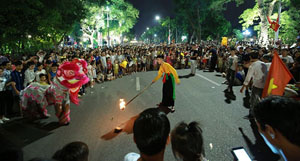


|
Illustrative Image According
to Nguyen Van Truc, who is Head of the Department of Art Management under the
Hanoi Department of Culture and Sport, the project will set the standard for
future performances in the city. The Hanoi Department of Culture and Sport
has sent a document to the cultural management agencies of other provinces
and cities, inviting them to come to Hanoi and enact special cultural and
artistic performances on the streets around Hoan Kiem Lake. Hanoi has created
the perfect conditions for the localities, with regards to performance space
and security.
Recently,
many localities from across the country have organised cultural art
programmes on the walking street around Hoan Kiem Lake to introduce local
culture and promote their destinations to tourists.
In
November
In March
2017, Quang Binh province organised ‘Quang Binh in the heart of Hanoi’, with
activities such as a photo exhibition and performances in "ca tru”
(ceremonial singing) and "ho khoan” (a genre of Vietnamese folk music
from Le Thuy district), as well as introducing the caves of Quang Binh.
Meanwhile,
Ben Tre province has introduced Don Ca Tai Tu (traditional musical art form
of the south) whilst Quang Nam province has promoted Bai Choi singing
performance in Hanoi. In the future, a series of cultural and artistic
performances of other cities and provinces will also be held.
In
addition, the walking street around Hoan Kiem Lake is a place in which
international artistic programmes can converge, including some of the world's
most famous art programmes. In March 2017, the world-famous London Symphony
Orchestra (LSO) presented the open-air ‘Vietnam Airlines Classic – Hanoi
Concert
Currently,
there are seven fixed places arranged for artists to perform in the walking
street around Hoan Kiem Lake, on weekend evenings. Octagonal House features
solo performances and concerts of traditional instruments and trumpets.
Meanwhile,
the Labour theatre’s door showcases extracts of plays, while the area opposite
the Ba Kieu temple is used to present traditional art programmes, such as cheo (traditional
opera), cai luong (southern folk opera) and quan ho (love
duet singing).
In
addition, Dong Kinh Nghia Thuc Square introduces a variety show and circus
programme and the Ho Guom cultural information centre’s door features modern
music. The area around Vu Le statue introduces Xam singing,
the Flower Clock area at the crossroads of Hang Bai - Hang Bai - Trang Tien -
Dinh Tien Hoang features Flamenco music performances and the zone around Ly
Thai To statue is used during major national holidays for the organisation of
cultural, artistic and sport related activities.
|